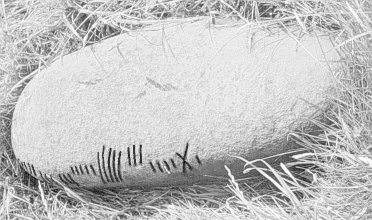Brash states that two of the stones were not found within the enclosure but "in an adjoining ditch", and that the "first person who noticed the inscriptions" was Henry Pelham who "mentions his having seen six inscribed stones" (OIM 200). According to Ferguson (OI, 31), "one perceives no fewer than eight of those rounded pebble-like blocks" on entering the enclosure; a ninth one {162} "lies outside the Killeen to the south".
Brash reports the "tradition of a bloody encounter in this locality, in which threescore men bearing the Christian name of Daniel were slain, all of whom were buried here". The spot was also called "Lisheen-na-Corig, or the little fort of the battle" according to him (OIM, 200).
Macalister (CIIC 1, 151) quotes Hitchcock for the suggestion that the stones might have been supplied from "Minard Strand, about six miles away", where "large numbers of them are to be seen" on the shore. Hitchcock "also observes that the worn condition of some of the inscriptions is a consequence of the action of the sportive youth of the neighbourhood, who were in the habit of rolling the stones about as a trial of strength"; the same report was given by Pelham before (in Vallancey, Collectanea 6, 199; n.v.).
Brash visited Ballintaggart on Sept 25, 1868. Before him, it was visited in 1838 and 1848 by J. Windele who made copies of the stones; further copies were made by Hitchcock [when?] (OIM, 201). Ferguson together with "Mr. Burchett" had casts made (OI, 31) which, however, "exhibit many imperfections" due to the peculiar shape of the stones. Other copies were prepared by J.R. Allen; these were used by Macalister for his treatment of the stones in Epig. (1, 32).
Size according to Brash, OIM 201: 3'2" x 1'2" x 8"
Size according to Macalister, CIIC: 3'2" x 1'2" x 0'6"
- Published illustrations:
- Macalister, CIIC 152 (sketch of inscription)
Reading Ferguson, PRIA 15, 1871, 61 sq.:
AXETRIFFI
Reading Brash, OIM 200 ("No. 1"):
âõåãéòñåäííåä
AEýAEFRITTI
Reading Ferguson, OI 33 (45.):
APEFRITTI
(This "seems to designate a son of Efritt. Efritt, Efratt is a name known in Patrician documents. The ap therefore may be an early form of the Welsh map, the equivalent of the Irish maqi". For the P-letter cf. also 44. {163} as well as the stone from Aglish {141}. - "There were two lines of British connection with Munster - one before the introduction of Patrician Christianity; the other, through the Welsh ecclesiastics who came in some Patrick's train. The first connection rests on both British and Irish authority dating from the time of Nennius; the second appears by a curious passage in the Glossary of Cormac, to the effect that the Welshmen who came with Patrick could not pronounce the Irish word Cruimthir (corrupted from Presbyter, a Priest), but called it Premter."
Reading Macalister, Epig. 1, 32 (12. / I.):
âõåãéòñåäííåä
AKEVRITTI
Reading Macalister, CIIC:
AKEVRITTI
Reading O'Kelly, JCHAS 50, 1945, 152:
Interpretation Korolev, DP 78:
AKEVRITTI
Reading McManus, Guide 65:
AKEVRITTI
Reading Gippert (1978):
 "Surface angle, right to left":
"Surface angle, right to left":
AKEVRITTI
âõåãéòñåäííåä
âõââââçççïïïïïâââââëëëæëëëâââââ
- Vallancey, Collectanea 6, 1804, 219 (H. Pelham);
- TRIA 30, 97: Graves "On an Ogham Inscription supposed to bear an Anglo-Saxon name";
- JRSAI 22, 1892, 155: J.R. Allen;
- AC April 1892, 132: Rhys/Allen;
- JRSAI 1896 (according to McNeill, riu 3, 45).
- TRIA 30, 97: Graves "On an Ogham Inscription supposed to bear an Anglo-Saxon name";
Additional literature:
Last changes of this record: 27.04.97
Copyright Jost Gippert, Frankfurt a/M 1996. No parts of this document may be republished in any form without prior permission by the copyright holder.
